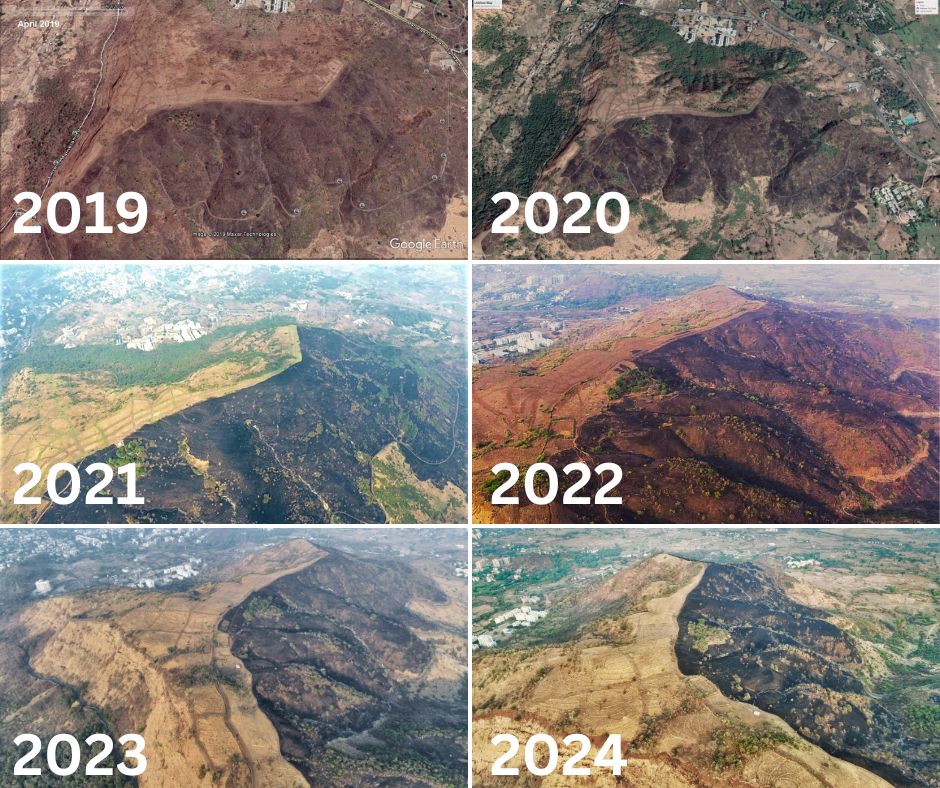Case Study
Transformative Impact of the Saguna Vansanvardhan Technique (SVT) on Hill No.2 (Nangarkhind)
The Hill No.2 (Nangarkhind), located in Neral, Raigad, Maharashtra, presents a compelling case study in the realm of sustainable forest management and wildfire prevention. Owned by the Forest Department and spanning over 150 acres, this area has become a testament to the effectiveness of the Saguna Vansanvardhan Technique (SVT). This 150 acres have been treated with SVT, a pioneering approach initiated in June 2018, aimed at revitalizing and protecting forest ecosystems.
This case study focuses on the northern part of the ridge, where the successful application of SVT has led to the arresting of wild forest fires. The evidence of this success is chronologically documented through satellite-based photographs from 2019 to 2023, offering a clear visual representation of the technique's impact over time.
The outcomes of these efforts have not gone unnoticed. Both national and international scientific communities have lauded the results, recognizing the significant environmental advancements made through the application of SVT. One of the most notable achievements in this area is the marked enhancement of soil quality and biodiversity. This improvement has led to the emergence of a perennial water source in naturally occurring dry waterholes, located 850 feet above ground level on the hilltop, an extraordinary feat considering the area's previous conditions.
Furthermore, the SVT-treated area has shown a greater percentage in the quality, diversity, and survival of plant species compared to areas affected by wildfires. Species such as teak, mahua, palash, terminalia species, etc. which previously struggled to survive, are now thriving post the emergence of grasses and shrubs on the plateau. This regeneration is a direct result of regulating wildfires through SVT, which has also facilitated the availability of quality fodder for domestic animals belonging to the local communities.
A key component of SVT's success in Hill No.2 is the contour-based plantations of Vetiver grass, Karonda, Wild banana, and grid-based plantations of higher plants, including Madhuca longifolia, Terminalia elliptica, Tectona grandis, and Gmelina arborea. This strategic approach is not just about preventing wildfires; it's about creating a sustainable ecosystem that can lead to succession-based climax forest conditions.
This case study aims to delve into the transformative journey of Hill No.2, exploring how the innovative application of SVT has reshaped an ecosystem, turning a once vulnerable area into a thriving, biodiverse, and sustainable environment. Through this exploration, we seek to understand the broader implications of SVT for forest management and wildfire prevention, not just in Maharashtra but potentially in similar ecosystems worldwide.
Sequential progress of application of SVT in a Hilly region
For implementation of SVT, a Hill amidst western ghats range near Matheran (Karjat Tehsil of Maharashtra) was chosen for research based demonstration. The successful arresting of wild forest fires is evident in the northern part of the ridge through application of SVT can be seen chronologically in the satellite based photos from 2019 till 2024.

Images clearly show that the SVT by way of creating a 10m wide anti-fire belt at the junction of the ridge and the plateau has led to regulation of wildfires with prevention of influence of the fire beyond the ‘belt’ created as a part of SVT.
The outcome of the efforts has been lauded by both- national and international scientific community.